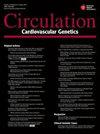Homozygous Familial Hypercholesterolemia in SpainCLINICAL PERSPECTIVE
Q Medicine
引用次数: 59
Abstract
Background— Homozygous familial hypercholesterolemia (HoFH) is a rare disease characterized by elevated plasma levels of low-density lipoprotein cholesterol (LDL-C) and extremely high risk of premature atherosclerotic cardiovascular disease. HoFH is caused by mutations in several genes, including LDL receptor ( LDLR ), apolipoprotein B ( APOB ), proprotein convertase subtilisin/kexin type 9 ( PCSK9 ), and LDL protein receptor adaptor 1 ( LDLRAP1 ). No epidemiological studies have assessed HoFH prevalence or the clinical and molecular characteristics of this condition. Here, we aimed to characterize HoFH in Spain. Methods and Results— Data were collected from the Spanish Dyslipidemia Registry of the Spanish Atherosclerosis Society and from all molecular diagnoses performed for familial hypercholesterolemia in Spain between 1996 and 2015 (n=16 751). Clinical data included baseline lipid levels and atherosclerotic cardiovascular disease events. A total of 97 subjects were identified as having HoFH—of whom, 47 were true homozygous (1 for APOB , 5 for LDLRAP1 , and 41 for LDLR ), 45 compound heterozygous for LDLR , 3 double heterozygous for LDLR and PSCK9 , and 2 double heterozygous for LDLR and APOB . No PSCK9 homozygous cases were identified. Two variants in LDLR were identified in 4.8% of the molecular studies. Over 50% of patients did not meet the classical HoFH diagnosis criteria. The estimated HoFH prevalence was 1:450 000. Compared with compound heterozygous cases, true homozygous cases showed more aggressive phenotypes with higher LDL-C and more atherosclerotic cardiovascular disease events. Conclusions— HoFH frequency in Spain was higher than expected. Clinical criteria would underestimate the actual prevalence of individuals with genetic HoFH, highlighting the importance of genetic analysis to improve familial hypercholesterolemia diagnosis accuracy.西班牙纯合子家族性高胆固醇血症的临床研究
背景:纯合子家族性高胆固醇血症(HoFH)是一种罕见的疾病,其特征是血浆低密度脂蛋白胆固醇(LDL-C)水平升高,且发生过早动脉粥样硬化性心血管疾病的风险极高。HoFH是由几种基因突变引起的,包括LDL受体(LDLR)、载脂蛋白B (APOB)、蛋白转化酶枯草素/酮蛋白9型(PCSK9)和LDL蛋白受体适配器1 (LDLRAP1)。尚无流行病学研究评估HoFH患病率或该病的临床和分子特征。在这里,我们的目标是描述西班牙的HoFH。方法和结果:数据收集自西班牙动脉粥样硬化学会的西班牙血脂异常登记处,以及1996年至2015年间西班牙所有家族性高胆固醇血症的分子诊断(n= 16751)。临床数据包括基线脂质水平和动脉粥样硬化性心血管疾病事件。共97例被鉴定为hofh,其中47例为真纯合子(APOB 1例,LDLRAP1 5例,LDLR 41例),45例为LDLR复合杂合子,3例为LDLR与PSCK9双杂合子,2例为LDLR与APOB双杂合子。未发现PSCK9纯合子病例。在4.8%的分子研究中发现了LDLR的两种变异。超过50%的患者不符合经典的HoFH诊断标准。估计HoFH流行率为1:45万。与复合杂合病例相比,真纯合病例表现出更具侵袭性的表型,LDL-C更高,动脉粥样硬化性心血管疾病事件更多。结论:西班牙HoFH发病率高于预期。临床标准低估了遗传性HoFH个体的实际患病率,强调了基因分析对提高家族性高胆固醇血症诊断准确性的重要性。
本文章由计算机程序翻译,如有差异,请以英文原文为准。
求助全文
约1分钟内获得全文
求助全文
来源期刊

Circulation-Cardiovascular Genetics
CARDIAC & CARDIOVASCULAR SYSTEMS-GENETICS & HEREDITY
CiteScore
3.95
自引率
0.00%
发文量
0
期刊介绍:
Circulation: Genomic and Precision Medicine considers all types of original research articles, including studies conducted in human subjects, laboratory animals, in vitro, and in silico. Articles may include investigations of: clinical genetics as applied to the diagnosis and management of monogenic or oligogenic cardiovascular disorders; the molecular basis of complex cardiovascular disorders, including genome-wide association studies, exome and genome sequencing-based association studies, coding variant association studies, genetic linkage studies, epigenomics, transcriptomics, proteomics, metabolomics, and metagenomics; integration of electronic health record data or patient-generated data with any of the aforementioned approaches, including phenome-wide association studies, or with environmental or lifestyle factors; pharmacogenomics; regulation of gene expression; gene therapy and therapeutic genomic editing; systems biology approaches to the diagnosis and management of cardiovascular disorders; novel methods to perform any of the aforementioned studies; and novel applications of precision medicine. Above all, we seek studies with relevance to human cardiovascular biology and disease. Manuscripts are examined by the editorial staff and usually evaluated by expert reviewers assigned by the editors. Both clinical and basic articles will also be subject to statistical review, when appropriate. Provisional or final acceptance is based on originality, scientific content, and topical balance of the journal. Decisions are communicated by email, generally within six weeks. The editors will not discuss a decision about a manuscript over the phone. All rebuttals must be submitted in writing to the editorial office.
 求助内容:
求助内容: 应助结果提醒方式:
应助结果提醒方式:


